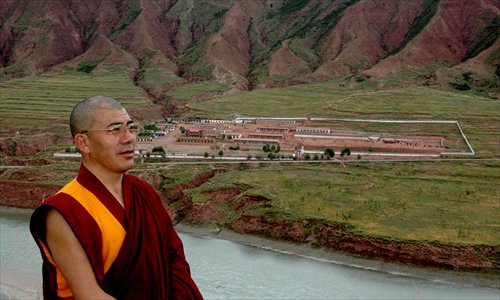

Above left: Headmaster Jigme stands on the bank of the Yellow River. Across the river is the overview of the whole school. Photo: Courtesy of Jigme Gyaltsen Welfare School
For 20 years, a Tibetan monk-cum-teacher in Qinghai Province has explored a new way to combine traditional and modern educational methods to open new horizons for the children of poor herdsmen. His success story has shown how a community can improve itself through social responsibility, ideas of equality and hard work.
There is a popular Tibetan saying: Every mountain, every river, every lake is sacred. And in every mountain, there live sacred souls.
Ani Gongqun Mountain is located in Golok Tibetan Prefecture, 400 kilometers, or eight hours by mountain road from Xining, the capital of Qinghai Province. Unlike other mountains on the Qinghai-Tibet Plateau, Ani Gongqun seems rough, desolate and calm, yet it has its own soul.
In Tibetan "Ani Gongqun" means "big bird spreads its wings." Indeed, it has wings. It stands watch over the Yellow River flowing before it and pilgrims turning prayer wheels at the 240-year-old Ragya Monastery.
At dawn, when the first rays of morning sun hit the golden roof of the monastery, bells toll and monks chant.
About 300 meters from the monastery, on the campus of the Jigme Gyaltsen Welfare School, students - both monks and lay learners - flood into their classrooms.
Tibetan monk and headmaster Jigme Gyaltsen, 49, stands in the middle of the campus and greets the students.
"Sangjie, keep up your studies, be more disciplined."
"Rengdan, are you feeling better? Make sure you stay warm."
"Gesang, how's your father. Is he OK now?"
He knows every student's name, where they come from, their problems and how hard it was for them to get into his school.
Knowledge can transform
Every September, thousands of applicants come to the school accompanied by their parents from other parts of Qinghai, Tibet, Sichuan, Gansu, Inner Mongolia, with some traveling thousands of kilometers to wait outside the school's main gate.
The school receives over 1,000 applications every year, but only 200 students can be enrolled. Enrollment is on a first-come-first-served basis with no exceptions; a close relative of the headmaster had to wait for three years to get into the school.
Twenty years ago, the school was founded with 3,000 yuan ($480) of Jigme's own savings, 130,000 yuan of loans, and Jigme alone teaching 80 students. Now it has more than 900 students and 38 teachers, one third of whom are Buddhist monks. There are no tuition fees and all accommodation is free.
"I started the school based on the idea of education for all," he told Global Times. "Many of the children of herdsmen don't have the chance to be educated. My purpose is that through learning both traditional and modern subjects, in the end, knowledge will elevate and transform us."
The youngest student at the school is 6 years old, while the oldest is 42.
"When the young and old study and live together, the young will learn a lot of things from older students. They will discuss things freely and be inspired to learn from each other," the headmaster said.
Awakening minds
Apart from courses on mathematics, physics, Chinese, English, computer technology and music, the school integrates many aspects of traditional Tibetan culture into the curriculum - Tibetan Buddhist logic, debating techniques, Tibetan classics, Tibetan medicine, Tangka painting and traditional architectural design.
Buddhist Logic (Hetuvidya) debates are key to the success of the school. Buddhist rational debate methods are applied to almost all academic disciplines at the school.
Every day, students spend 30 minutes at noon and 40 minutes in the afternoon debating their newly acquired knowledge with their classmates and teachers.
"Debates are extremely helpful to summarize what we have learned during the day. They help me to consolidate my knowledge and to inquire further and deeper, " says Gengdeng Zongzhi, a student at the school.
"Tibetan monastic learning does not only stress reciting and memorizing, it also encourages creative thinking," said Cizhi Jiacuo, the school's deputy headmaster. "Students are encouraged to question each other and their teachers. Debates awaken students' minds."
Each Thursday there is a festival on the campus in which all of the teachers and students dress up in traditional Tibetan robes. There are quizzes on poetry, religion, math, law and science. The English class performs a play, while others recite Chinese poems. A few perform a fragment of the classic Tibetan epic of King Gesar and some compete in Tibetan calligraphy and painting.
"Buddhist debate and weekly contests represent the openness of knowledge, releasing creativity. It is the organic combination of both traditional and modern educational advantages. It aims to encourage students to gain self-consciousness, creativity and sharpness." wrote noted education expert Yang Dongping on his blog after visiting the school.
Copyright ©1999-2018
Chinanews.com. All rights reserved.
Reproduction in whole or in part without permission is prohibited.